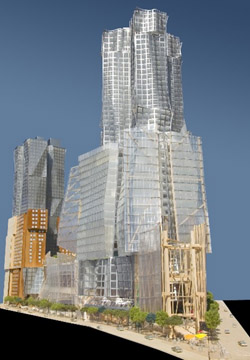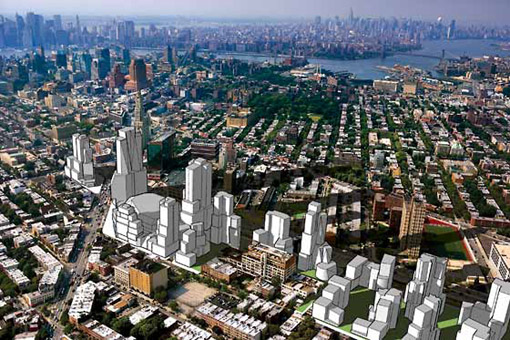What Went Wrong With “Atlantic Yards?”
An Interview With Kent Barwick, President of the Municipal Art Society

"There is disappointment, annoyance, and anger because there hasn’t been any way for anyone to have a voice. Who is listening to the people living around Atlantic Yards?"
With the Pataki Adminstration scrambling to beat the buzzer and win approval for Forest City Enterprise’s "Atlantic Yards" mega-project before the inauguration of Governor-Elect Eliot Spitzer, journalist Ezra Goldstein talks to Municipal Art Society President Kent Barwick about the problems that arise when communities are locked out of the development process in their own neighborhoods.
Municipal Art Society President Kent Barwick has been attacked for not condemning Forest City Enterprises plan to drop 17 high rises and a 19,000-seat basketball arena in the middle of Prospect Heights, Brooklyn. He has also been criticized for being too concerned about process when, say his critics, the basic concepts behind the immense Atlantic Yards project are fatally flawed. To Barwick, however, process is paramount, and Atlantic Yards is the poster child for what goes wrong when process is ignored.
Barwick says that the people of Brooklyn and their elected representatives have been shut out of planning for Atlantic Yards and all major decisions have been made behind closed doors. The result is a poorly designed project that has polarized the community and that squanders both opportunity and public trust.
The project can be saved, he says, but only if people are given the chance not just to speak but to be heard. That would happen if the state recognizes that, properly, its client at Atlantic Yards is the citizens and government of New York City, not a private developer.
That is no radical notion, argues Barwick. It is law and policy embedded in regulations and the city charter, thanks in large part to agreements he and the MAS helped hammer out two decades ago after a prolonged battle with the Koch administration over the proposed sale to a private developer of publicly owned land on Columbus Circle.
The city, says Barwick, is obligated to solicit ideas from the public, develop a master plan, put out an RFP (a request for proposals) and then consider bids from several developers before it can give up a significant piece of land. More public hearings follow before construction is allowed to begin. It may be a cumbersome and imperfect process, Barwick admits, but in project after project, the end result has been far superior to the initial concept.
 At Atlantic Yards, a private company developed plans for the 22-acre site before Brooklyn’s communities had a chance to say a word, and long before a token RFP was issued. The community boards, guaranteed participation in neighborhood planning in the 1975 and 1989 revisions to the city charter, were completely shut out of the process, as were Brooklyn’s democratically elected City Council members. The developer never publicly asked the advice of the highly capable (and taxpayer funded) staff at the Department of City Planning which had just completed a major rezoning of Downtown Brooklyn adjacent to the project’s footprint.
At Atlantic Yards, a private company developed plans for the 22-acre site before Brooklyn’s communities had a chance to say a word, and long before a token RFP was issued. The community boards, guaranteed participation in neighborhood planning in the 1975 and 1989 revisions to the city charter, were completely shut out of the process, as were Brooklyn’s democratically elected City Council members. The developer never publicly asked the advice of the highly capable (and taxpayer funded) staff at the Department of City Planning which had just completed a major rezoning of Downtown Brooklyn adjacent to the project’s footprint.
The first time Brooklyn residents heard that Forest City Ratner Companies intended to build 16 skyscrapers and an arena in the middle of their borough, it was presented largely as a fait accompli. That was allowed to happen because the city had ceded responsibility for the site to the Empire State Development Corporation (ESDC), and the ESDC, bluntly, operates above the law. The ESDC has the power to override New York City law and policy, and that is precisely what it has done.
The ESDC was established in the 1960s as the Urban Development Corporation (UDC) with the best of intentions, says Barwick. Its primary function was to get economically mixed housing built outside poor neighborhoods, and "Governor Rockefeller recognized that you couldn’t integrate society if you didn’t have a way to break through local zoning laws. The UDC act gave the state the mechanism when necessary to break local zoning codes to achieve a higher purpose."
But, Barwick says, "that has evolved now into a situation where virtually all major projects in the state use the UDC act, because it is virtually impervious to challenge. UDC projects don’t have to conform to local zoning, or pay any attention to historic preservation, and they give the state the power of eminent domain."
UDC projects also "bypass virtually every opportunity there is for citizens to voice their opinion."

Barwick describes the public hearings on the Draft Environmental Impact Statement for Atlantic Yards, which came more than two years after Forest City Ratner first presented plans for the site, as "the beginning and the end of the public process." The unelected, unaccountable officials at the ESDC can override even this small bit of public input because they have the power to ignore the final environmental impact statement.
Barwick describes multiple negative repercussions of this non-inclusive, top-down, closed-door process. Large segments of the community have been pushed into warring pro and con camps, and not just the state but also the developer have forsaken input that could have vastly improved the plans for Atlantic Yards.
"There is disappointment, annoyance, and anger because there hasn’t been any way for anyone to have a voice," he said. "Who is listening to the people living around Atlantic Yards? There’s nowhere for them to go and talk, and what processes there are have been anti-democratic and frankly discourteous, and no one should be astonished that many people are angry and disaffected."
 As a result of the way Atlantic Yards has been mishandled, said Barwick, "a lot of people ended up either in an organized cheering section or sending in $10 donations to fund a lawsuit against eminent domain. I’m not demeaning either of these positions, but it’s not exactly a public approval process leading to a better project."
As a result of the way Atlantic Yards has been mishandled, said Barwick, "a lot of people ended up either in an organized cheering section or sending in $10 donations to fund a lawsuit against eminent domain. I’m not demeaning either of these positions, but it’s not exactly a public approval process leading to a better project."
Barwick insists that the project still can be turned around if the people are invited into the process. This faith in the benefits of citizen participation is the cornerstone of one of the Municipal Art Society’s major ongoing initiatives: the Campaign for Community Based Planning. The campaign would mandate citizen involvement working through community boards to shape the future of their neighborhoods. (Not surprisingly, the campaign’s web site provides links to the Atlantic Yards DEIS and General Project Plan as "exemplars of those things wrong with the existing system.")
"In our view, the potential for people to be involved in the future of their own neighborhoods is obvious," said Barwick.
In community based planning’s ideal model, government decides on overarching needs, because, said Barwick, "there are some decisions that can only be made on a citywide or regional or state level, like where highways or subways should go, or how health care delivery systems should operate, or how much growth a community should be encouraged to absorb, or how many units of low-income housing need to be built.
"But once a central government has made major decisions, most of the other decisions are ones that local communities are better equipped to handle. They know the physical and human landscape better than anyone else. It is essentially a dialogue: elected government sets standards or targets, but how those targets are realized is determined locally."
It’s not a plebiscite or a poll, Barwick insisted, and elected officials eventuarlly make the final decisions, but those decisions are wiser when the public is involved. "Of course it’s a more cumbersome process than having [ESDC chairman] Charles Gargano and [Deputy Mayor] Dan Doctoroff in a room," he said, "but you also have a better result."
 By Barwick’s reckoning, he has sat through hundreds of public hearings over the years, which included a stint as chairman of the Landmarks Preservation Commission. "I have never gone away from a public hearing without having learned something," Barwick observed.
By Barwick’s reckoning, he has sat through hundreds of public hearings over the years, which included a stint as chairman of the Landmarks Preservation Commission. "I have never gone away from a public hearing without having learned something," Barwick observed.
Barwick describes how MAS gathered ideas from some 10,000 people after the destruction of the World Trade Center for its project, Imagine New York: Giving Voice to the People’s Visions. Ordinary citizens, he said, had excellent ideas for what should be built on the WTC site-ideas that have been largely ignored by the Lower Manhattan Development Corporation, a subsidiary of the ESDC.
Barwick argues further that NIMBY (not in my backyard) is not the rule when the public gets involved, contrary to what is said by some defenders of ESDC involvement in Atlantic Yards. "We are aware of community based plans that have been implemented in more than 50 communities," he said, "and they have been much more responsive to absorbing growth than critics assume." (Community based planning is state law in Minnesota, and has been widely used in such cities as Seattle, Baltimore, Washington, and Rochester),
Barwick does not think it is too late to salvage at least part of Atlantic Yards. "I don’t think this project is substantially designed in its later phases," he said, pointing out that it could be a decade before construction begins on much of the housing and retail space even if the ESDC rubber stamps the project this winter. "Battery Park City and Riverside South got redesigned several times before they got built," observes Barwick.
"There’s no reason a new governor couldn’t open up the process and get good design people involved. Even neutral architects I have talked to give a failing grade to the developer’s plans for open space, retail space, circulation, and the like. I would like to see the governor create a board above suspicion that has the trust of the public to guide the project from here on out.
"I’m not saying [developer] Bruce Ratner is a bad guy or a crook. I don’t think he is. But there’s no public present. No public official present. This project is far too big and far too important to be left to a private developer. It must involve the public."
Get the process right, Barwick argues, and good ideas will follow. Get the process right, and Atlantic Yards could still be saved from itself.
For information on the Community Based Planning Campaign, see the Municipal Art Society web site and download their booklet, Livable Neighborhoods for a Livable City (PDF). Also see the Brooklyn Speaks web site. This article was originally published in the Park Slope Civic Council newsletter.
Photo renderings copyright of Jonathan Barkey